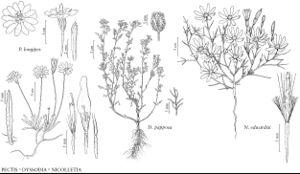Nicolletia
in J. C. Frémont, Rep. Exped. Rocky Mts., 315. 1845.
| Taxon | Illustrator ⠉ | |
|---|---|---|
 | Pectis longipes Dyssodia papposa Nicolletia edwardsii | John Myers Marjorie C. Leggitt Yevonn Wilson-Ramsey |
Annuals or perennials, (5–) 10–50 cm, often glaucous. Stems erect or spreading, branched from bases or throughout. Leaves cauline; mostly alternate (1–4 proximal pairs opposite); blades mostly 1-pinnately lobed (lobes usually 3–11, bristle-tipped), ultimate margins entire, faces glabrous (often glaucous, oil-glands subterminal). Heads radiate, borne singly. Calyculi of 2–6 deltate to lanceolate bractlets (each usually bearing 1–5 oval to linear oil-glands). Involucres campanulate to turbinate or fusiform, 4–8 (–10) mm diam. Phyllaries persistent, 6–12 in ± 2 series (distinct to bases, lanceolate or ovate to linear, most bearing 1–5 oil-glands). Receptacles convex to conic, ± pitted, epaleate. Ray-florets 7–12, pistillate, fertile; corollas whitish with pinkish to purplish stripes. Disc-florets 15–100+, bisexual, fertile; corollas yellow or purplish or whitish, tubes much shorter than cylindric throats, lobes 5, deltate to lanceolate. Cypselae clavate, sparsely puberulent (hairs usually reddish); pappi persistent, of 5 (–6) fascicles of 7–15 barbellate bristles subtending and alternating with 5 (–6) lanceolate, 1-aristate scales. x = 10.
Distribution
sw United States, n Mexico
Discussion
Species 3 (2 in the flora).
Nicolletia trifida Rydberg is known from Baja California and Baja California Sur, Mexico.
Selected References
Lower Taxa
Key
| 1 | Leaf lobes 5–11, rachis widths mostly 2–3 times lobe widths; ray laminae 4–8 mm; disc florets (30–)60–100+ | Nicolletia occidentalis |
| 1 | Leaf lobes mostly 3–5, rachis widths hardly greater than lobe widths; ray laminae 7–16 mm; disc florets 15–25(–50) | Nicolletia edwardsii |